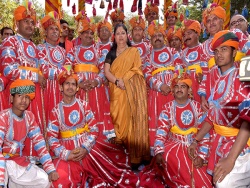
Why Indian Rajah rush into politics
In Indian politics every year more and more aristocratic names. The descendants of the ancient dynasties that after India gained independence almost lost his income and barely scraped by, thanks to sweeping India fashion back to the roots got a second chance. For the honor of having in its ranks the descendants of rajas, Maharajas, Nawabs and the nizams are fighting the biggest party of the country. The reasons for this popularity were dealt with “Tape.ru”.
Gold can not be too much
By the time of the breakup of British India in its territory there were about 600 native principalities. Their rulers formally recognized the “suzerainty, but not sovereignty” to the British crown, abandoning independent foreign policy in exchange for absolute power within his realm. Many feudal lords possessed fabulous riches: the status of the last Nizam (Bishop) of Hyderabad Asaf Gaha VII was two billion US dollars or two percent of the then U.S. GDP. It minted its own currency, contained 86 mistresses and a huge staff of servants, and as a paperweight used 184,5 diamond in carats.
In 1947, after the partition of British India, the feudal lords had to choose which of two newly formed States to join the Indian Union or Pakistan. But the real choice was only the princes, whose possessions were situated on the border. Those who tried to go against fate and geography, quickly given to understand, than it threatens. An example was the fate of the above mentioned Nizam of Hyderabad, a Principality which was situated in the centre of Hindustan. Cost to bring up the idea of accession to Pakistan, as Indian authorities have begun against him punitive operation. 22-thousand army of the Nizam was defeated in five days, killing nearly two thousand people, and Hyderabad capitulated, agreeing to remain part of India.
The other princes were not to tempt fate and signed a contract with the Central government of India, voluntary-compulsory passing in new Delhi the right to collect taxes from residents of their territories. In exchange, the government agreed to pay them a round sum — the so-called “personal purse” (privy purse). The territory of the principalities were United in “States of type B”, managed by the councils of lords. However, in 1956 the States were completely reorganized on linguistic grounds, and the former Raja had lost all authority.
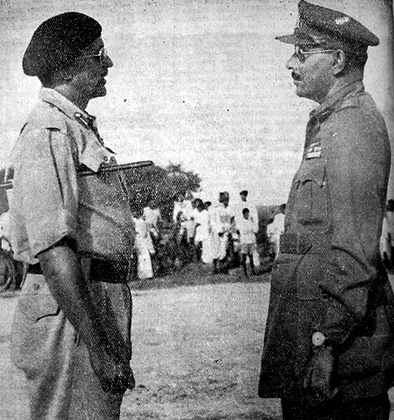
The commander of the Hyderabad army major General El-Aidroos (right) surrendered to Indian forces
Photo: ourhyderabadcity.com
A cold shower for Raja
Mostly Indian princes at this time just lived money accumulated by generations of their ancestors. Some of them were shrewd enough to choose a political path. For those who have decided to stand for Parliament, it was a Golden time. “When His Highness the Prince of Jaisalmer Raghunath Singh Bahadur was decided to be elected to Parliament, he wouldn’t need to campaign, says one of his descendants, kesari Singh Bhati. — His Highness has never been in the district from which he ran to win the support of voters. He sat in his Palace, and yet had received all necessary votes. Why? Yeah people just understand it nothing is taking this away from them. He can they take? He can only give them something”.
However, over the princes was more and more clouds gathered. The permanent governing party, Indian national Congress (INC), to build a new India in which no place for remnants of the past. Over the Maharajas and nizams deservedly mocked in the press, they drew the cartoons, the Newspapers wrote about how the princes binge-eating caviar while ordinary Indians die of hunger. In Indian society intensified anti-feudal sentiment.
In 1969, the Indian authorities decided that enough to spend the huge sums for the payment of his personal money to the princes. In Parliament submitted a draft on the abolition of the “personal wallet”, which lacked only one vote to become law.
The feudal lords felt threatened, and in the elections in March 1971, EN masse ran for the Parliament to block further initiatives to limit their rights. They waited for a cold shower: in almost all districts, the aristocrats suffered a humiliating defeat. Inspiring victory in the election, the government INC. held 26 th amendment to the Constitution of the country, committed with “personal wallets” and deprived the princes of their livelihoods.
Beauty Queen
The symbol of the resistance of the aristocracy to the new realities became Gayatri Maharani Devi of Jaipur. Finished school in London and University in Lausanne, she was noted for amazing beauty (Vogue magazine included her in the list of the ten most beautiful women in the world) and was a sophisticated politician. The first parliamentary elections it won in 1962, at the age of 47, standing from the opposition “Swatantra party”, and since then the results of each vote has consistently retained its seat in the lower house. Despite the fact that her husband held an important post in the Indian Foreign Ministry, it has repeatedly rejected proposals to change sides and join INC. In the mid-1970s, when the country was under a state of emergency, “congressiste” took the opportunity and took revenge Gayatri: on false charges she was imprisoned for five months, after which Maharani withdrew from politics.
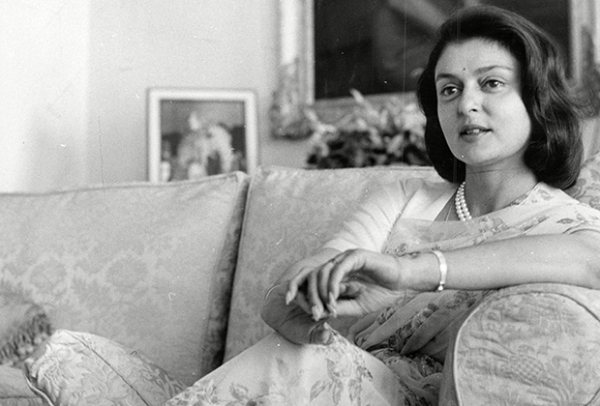
Gayatri Maharani Devi at the age of 42
Photo: David Steen / Associated Newspapers / REX Shutterstock
The seventies and eighties were for Indian feudal time of decline. Their revenue sources have dried up, to do business they were not allowed family pride and caste prejudice. The most completely ruined, most the rich survive at the expense of sales of family values. But here, not everyone was lucky: for example, treasures of the Nizam of Hyderabad have been declared a national treasure, and his descendants could not sell a single stone.
Would be the transformation of the luxury residences of feudal lords in hotels and museums, but in those years, India has not yet gained popularity among tourists. Jodhpur Maharaja Gaj Singh II recalled that once he was on the verge of starvation: the grocer refused to release the former Prince of the goods on credit as long as he will not return the debt. At this time, the Maharaja lived in luxurious Umaid Bhawan Palace, and all his money was spent on stipends for the numerous servants who could not just drive out onto the street: their ancestors served the family of the Jodhpur rulers for many generations. Now in Umag-bhavana is a five — star hotel, part Museum, the former Maharaja providing stable income and allowing you to earn extra money to the servants, many of them willingly photographed with tourists for a few dozen rupees.
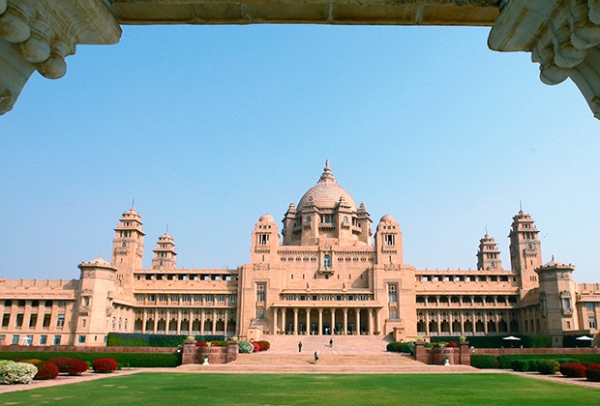
Umaid Bhavan, formerly the Palace of the rulers of Jodhpur, now a five-star hotel
Photo: Vijay Mathur / Reuters
The revival of traditions
An example of Gaj Singh is not unique: the princes, who managed to hold on until the 1990s, began to remodel their possessions into museums and hotels.
At this time in India began economic reforms: it is becoming increasingly estranged from the state regulation policy, developing private business in the country foreign investments. Together with the liberalization of the economy and the refusal of building “socialism in the Indian” society embraced the desire to return to the roots: the Newspapers, which had ridiculed the aristocracy, began to write about them in a nostalgic tone. Former feudal lords, almost driven out of politics, began to return to her. Them with open arms took the opposition “Bharatiya Janata party” (BJP), relying on conservative values.
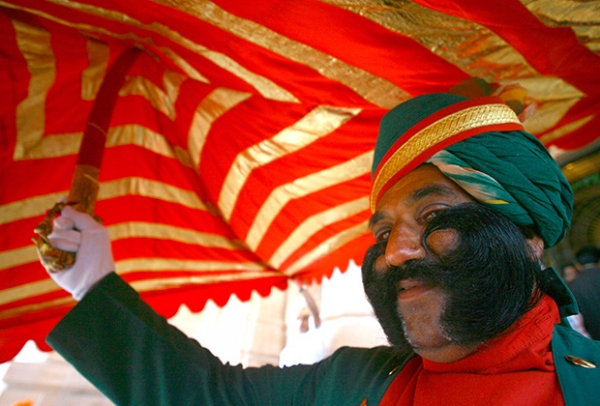
Protection Umid-Bhavana willingly posing for photographers for a few dozen rupees
Photo: Vijay Mathur / Reuters
“We, the princes of the warrior caste of Rajputs, are born to fight for my country, says the heir of the lords of Jaisalmer kesari Singh Bhati. But now we can’t just take the sword and rush into battle. Where else can we lead people to do things, which gave birth to the mother, if not in politics? People are still waiting on our gifts and labors, but people only listen to those who have power”.
The symbol of the second coming of the aristocracy in power was Vasundhara Raja is the heir of the ancient rulers of Gwalior married to Hemant Singh, one of the descendants of the family of the princes of Dholpur in the present state of Rajasthan. Raja four times was elected to the Parliament of the state, five in the lower house of the Indian Parliament. In 2003 she topped the list of the BJP in the elections to the legislative Assembly of Rajasthan and led the party to a decisive victory, becoming the chief Minister of state first woman and the first royalty on this post for the whole story.
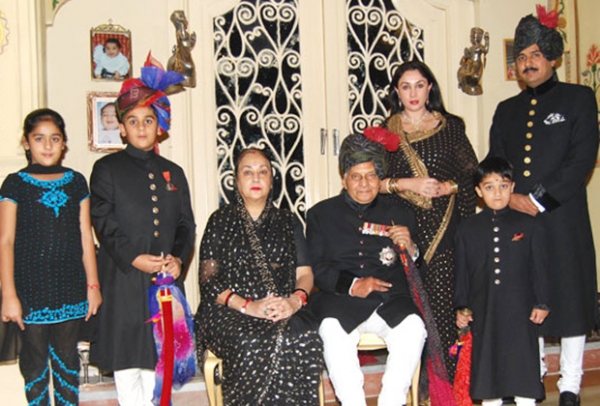
Princess Diyya Kumari (standing) with his family
Photo: personal page Princess Diya Kumari in Facebook
Not far behind her and 45-year-old Diyas Kumari of Jaipur — granddaughter beauties Gayatri Devi. During the visit of Narendra modi in Jaipur during the election campaign, when the town square has gathered a 200-strong meeting, she solemnly announced to join BJP. After that Kumari was in the local Parliament and now appears on almost all major charity events, to earn political points for the battle for the place of the Deputy of the Parliament of India.
Old enemies — new friends
The leaders of the Indian national Congress, held once irreconcilable anti-feudal position, caught the fashion of the aristocracy and more and more talk about traditions, trying to intercept slogans of the BJP and actively involving your former feudal lords.
The most famous aristocrat in the ranks of ex-adamant fighters against feudal privileges — Chandresh Kumari, the heiress of the lords of Jodhpur chosen by a member of INC. in 2009 and became the culture Minister in the last government of Manmohan Singh. Although the results are devastating for the Congress elections 2014 in the Parliament she did not get, abandon a political career, Chandresh Kumari is not going to. In the ranks of the INC are also the heir of Galskogo of the Principality of Bharatpur, Vishvendra Singh and his wife Divya, Igarage Singh, the Prince of the Principality of Kota, Kunwar Vikram Singh, Maharaja Chattarpur and many others.
Sometimes members of Royal families differ in sympathy. A typical example is the family Institute — the ancient rulers of the Principality of Gwalior: Yashodhara Raje Shinde, the convinced supporter of BJP, is now the Minister of trade and industry in the state of Madhya Pradesh, while her nephew jyotiraditya madhavrao of the Institute, the official Maharaja of Gwalior, is a member of the lower house of India’s Parliament from the INC.
I’ll give you a gold coin
The return of former princes in the policy satisfied not all. Someone sees this as evidence of social injustice, a departure from the principles on which was built a modern India. There are those who have the score to royals is much more serious.
Azam Khan, a former leader of the socialist “Samajwadi party” from the state of Uttar Pradesh, has turned the fight against the descendants of the rulers of the princely state of Rampur in the business of life. “I grew up on stories about how the Nawabs of Rampur were oppressed and exploited the ordinary people, said Azam Khan. — These stories still feed the flame of my wrath.”
But many ordinary voters feel towards the descendants of rajas, Maharajas, Nawabs and nizams of other feelings — nostalgia for the “good old days” and the “Golden age”, the reflection of which still falls on the ancient name. But it’s not just nostalgia. Raja, the bins which are full of family wealth, is unlikely to affect the scourge of Indian politics — corruption.
“His Highness maharao so much money, so much land that he would never stoop to taking a bribe, says kesari Singh Bhati. — Money it does not matter. If he comes to me to hint at a bribe, people will be shocked. You can drive all the former Principality of Kota and ask extorted the Prince who has some money. If there is a person to respond positively, the same night I’ll cross the border and go to Pakistan”.








